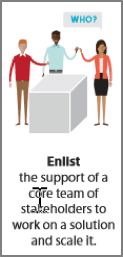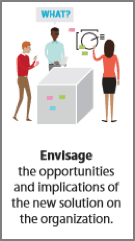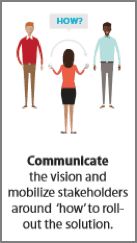Mark's Note: Today's post is by a new contributor, Nathalie Khodr. We met a few years back in San Antonio thanks to our shared interests in Lean and healthcare improvement. Nathalie asked to write a post that reflected on her participation in my “ExperienceChange” workshop earlier this year.

As continuous improvement professionals, it is our role to impact a business in significant ways. We typically work in teams to study processes, identify wastes, analyze them and introduce solutions. No matter what improvement methodology is used, the most difficult aspect of our work is in affecting a cultural shift towards systematic improvement and in sustaining such a shift in the long term.
Certainly, this isn't a revelation to anyone who has spent a reasonable amount of time in the continuous improvement arena. Many of us have experienced different forms of resistance, from denial about the issues, to passing on the blame, hiding information, and in some unfortunate cases, bursts of anger (see Dr. Kubler-Ross's 5 stages of grief. In fact, as soon as the status quo is challenged and disruption occurs, emotional reactions surface at various levels of the organization.
MIT professor Edgar Schein defines organizational culture as:
“…a pattern of shared basic assumptions that a group has learned as it solved its problems of external adaptation and internal integration, that has worked well enough to be considered valid and therefore, to be taught to new members as the correct way to perceive, think, and feel in relation to those problems”.
As leadership has a strong influence on organizational culture, their strong commitment and engagement is necessary to implement change. It is also why shortcomings in those areas are cited as the principal reasons for change initiative failures. In Schein's words:
“…the only thing of real importance that leaders do is to create and manage culture. If you do not manage culture, it manages you, and you may not even be aware of the extent to which this is happening.”
Therefore, our goal is to influence those leaders by giving them a new way to think.
Early on in their careers, continuous improvement professionals learn to implement tools such as standardized work, visual management and control plans, which help sustain process change initiatives. Other critical elements that are not always implemented but are critical to a successful improvement program are alignment to vision, leaders' standard work and accountability. However, all of these tools are irrelevant if people in an organization do not use them. At the end, it is them who determine the successful implementation of improvement initiatives. This is why it is critical to use an effective change management strategy.
“Change management is the process, tools and techniques to manage the people side of change to achieve the required business outcome” (Source).
Some popular change management approaches are: ADKAR (Awareness-Desire-Knowledge-Ability-Reinforcement), Kurt Lewin's Unfreeze-Change-Freeze model, Kubler-Ross five stages (5 stages of grief), and Kotter's eight steps model which ExperiencePoint‘s workshops are heavily based on.

ExperiencePoint is an award-winning training company which has developed a hands-on approach to learning change management principles. The one-day “ExperienceChange” workshop I attended was facilitated by Mark Graban, influential Lean speaker, consultant and author. The workshop is structured around a software simulation of the change process related to a hospital's Emergency Department (ED). The hands-on approach is extremely beneficial for kinesthetic learners (such as me), and the numerous group interactions were critical in internalizing change management concepts.
There are many important lessons to be learned by attending one of the workshops. I will share here only three key points which were relevant to me and my work with organizations:
A Stakeholders' Analysis is Essential
A few years ago, I learned about the concept of ‘2-6-2'. This simple rule states that in a group of 10 people,
- 2 are ready for change and will lead or assist with change initiatives
- 6 will wait to see the benefits before joining the change team
- 2 are not interested in change, will not join the team and may even work against the change efforts
 Even though I always kept the ‘2-6-2' concept in the back of my mind, I never considered it to be a practical tool for assessing individual attitudes. Through the ExperienceChange simulation, I was introduced to a set of tools and templates to manage stakeholder analysis. During the workshop, our team was able to pick from a team of ED and leadership staff, and conduct interviews from a list of questions. Based on the responses received, the team assessed the level of engagement and categorized individual staff as either ‘resister', ‘bystander', ‘helper' or ‘champion' of change.
Even though I always kept the ‘2-6-2' concept in the back of my mind, I never considered it to be a practical tool for assessing individual attitudes. Through the ExperienceChange simulation, I was introduced to a set of tools and templates to manage stakeholder analysis. During the workshop, our team was able to pick from a team of ED and leadership staff, and conduct interviews from a list of questions. Based on the responses received, the team assessed the level of engagement and categorized individual staff as either ‘resister', ‘bystander', ‘helper' or ‘champion' of change.
The more accurate the assessment, the more successful the change management effort, measured by the level of buy-in. One additional note to change managers: Before creating a change team, it is important to evaluate the level of commitment needed as well as the critical actions required to achieve success.
Create a Strong Case for Change
I will admit that in the past, I have taken for granted the need to create a strong case for change. After all, wasn't I hired to lead change initiatives? Wasn't I hired because the organization knew it needed change? Is there really a need to reinforce what should be obvious to all?
 It turns out that many organizations do not necessarily hire to effect change. Instead, they may hire for image, to fill an open position without understanding why it became vacant in the first place, or other bad reasons. When improvement professionals are hired for the wrong reasons, the responsibility for improvement often gets “offloaded” on them along with the responsibility for leading, implementing and managing change.
It turns out that many organizations do not necessarily hire to effect change. Instead, they may hire for image, to fill an open position without understanding why it became vacant in the first place, or other bad reasons. When improvement professionals are hired for the wrong reasons, the responsibility for improvement often gets “offloaded” on them along with the responsibility for leading, implementing and managing change.
For this reason, one of the critical lessons I learned through the ExperienceChange workshop is the need to build a credible case for change. It must be based on a good understanding and rendition of the existing problem, should include environmental/market place demands when applicable, and must highlight the cost of inaction or other financial impact. A strong case for change speaks volumes to the leadership, and creates or reinforces their motivation to act as the champions of change.
Implement a Plan to Communicate Effectively
 Because it is about modifying people's behavior, change managers must have a good communication plan. That plan should take into consideration the type and frequency of communication needed to truly affect change. Most improvement professionals are trained to work well in teams and, consequently, develop good relationships in the organizations in which they work. They communicate often, seek input, and share pertinent information freely. All of these are essential for the success of change initiatives, but these basic skills may not be enough. The communication plan is one of the tools offered through the ExperienceChange workshop and is helpful in bridging the communication gap.
Because it is about modifying people's behavior, change managers must have a good communication plan. That plan should take into consideration the type and frequency of communication needed to truly affect change. Most improvement professionals are trained to work well in teams and, consequently, develop good relationships in the organizations in which they work. They communicate often, seek input, and share pertinent information freely. All of these are essential for the success of change initiatives, but these basic skills may not be enough. The communication plan is one of the tools offered through the ExperienceChange workshop and is helpful in bridging the communication gap.
Often, subgroups within organizations have their own preferred communication method. Financial teams will look for dollars and cents, whereas regulatory groups will be affected by compliance metrics. There is a myriad of communication tools, from scorecards to internal blogs, from newsletters to emails, etc. Some forms of communication may be easier from a planning perspective, but inefficient for successful communication with certain groups. A well drafted communication plan takes all of these factors into consideration, and lists people affected by the change, the impact of the change, the goal of the communication and the person responsible for it. It must also include the leadership's role in sharing the vision and reinforcing the change initiatives at regular intervals.
There are many more concepts explained and best assimilated by working through the ExperienceChange simulation at one of the upcoming workshops. For more information on the workshops, click here. To read more Continuous Improvement written by this author, please visit LeanCIJournal.com.
What do you think? Please scroll down (or click) to post a comment. Or please share the post with your thoughts on LinkedIn – and follow me or connect with me there.
Did you like this post? Make sure you don't miss a post or podcast — Subscribe to get notified about posts via email daily or weekly.
Check out my latest book, The Mistakes That Make Us: Cultivating a Culture of Learning and Innovation:










This blog article presents a compelling argument for adopting Lean principles in change management, advocating for a more flexible and adaptive approach. Reflecting on my own experiences, integrating Lean methodologies has proven to streamline processes and foster a culture of continuous improvement amidst organizational transformations. The insights shared in this article resonate deeply, underscoring the importance of embracing change as an opportunity for growth and innovation.
This blog article on lean change management offers valuable insights into reshaping traditional approaches. Drawing from my own experience in implementing lean principles, I’ve found that fostering a culture of continuous improvement leads to more sustainable and impactful change. By embracing flexibility and engaging employees at all levels, organizations can navigate transitions with greater agility and success.